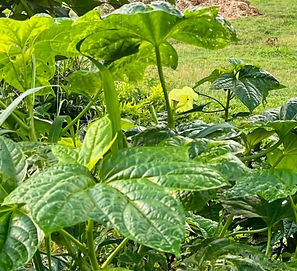




Bele is grown throughout the tropics but most importantly in the Pacific Islands...
Bele, also known as Tahitian spinach or Tongan spinach, is a leafy green vegetable with cultural and historical significance in the Pacific Islands, particularly Tonga and Samoa. It serves as a traditional food source, symbolizing abundance and hospitality in gatherings and feasts. Cultivated for generations, bele is resilient and adaptable, providing essential nutrients and medicinal properties. It is versatile in the kitchen, used in various dishes, and contributes to food security and sustainable agriculture in the region. Efforts to preserve bele promote cultural heritage and local food sovereignty in the face of modernization and globalization.
Sow! Start Bele from cuttings...

You can purchase cuttings from Food First Nursery or already rooted plants grown in Ma Mix. Once your bele plant is growing you can add more to your edible hedge cutting branches around and inch thick and replanting them. Bele loves sun so choose a place with plenty light. Is the soil is compact add mulch, compost or Ma Mix to increase water drainage.
We like to keep our Bele at around 4 ft tall and harvest the top leaves. This will give you asteady supply and increase the stability of the plants..
Grow Bele: you are in luck cuz bele just grows... and grows

Watering
Bele can use a daily watering for a few minutes if you put in a timed drip system. Otherwise use your hose or watering can.
Fertilizing
Bele doesn't really need much food more then the soil gives it however if the leaves turn light or yellow give it a shot of nitrogen rich fertilizer. Nitrogen promotes leaf growth and bele is all about the big dark green chorophyll rich leaves.
Protecting
Bele is good eating for humans and for bugs as well. It grows so fast that you can afford to share. However if want to keep the bugs away you can spray the leaves with Neem Oil or another organic bug repellent.
Pick It!
Scissors or snippers just cut the leaves on off the top or sides of your bele hedge...when you keep it low its easy.
You won't be-leave the leaves. They can be huge. So just lay one on the other and fold them into a bag. This will allow them to keep in the frig for a couple of days.
You can use the stems!
chef Heid made a delicious salad topper from marinated bele stems.
Stick It: get your bele on. Raw, sauted, smoothie, casserole theres a role for bele in every meal.
Spinach is currently selling for $14 a pound ! in Hawaii. Substitute your own bele! Popeye approved.

Bele Smoothie
Fold or roll the leaves and slice into strips.
Add 1 cup banana fresh or frozen, 1 cup of papaya and 2 cups of bele. Put it in your blender (we use vitamix for the power) and blend until leaves are liquid super green.
Simple Bele Stir Fry

Ingredients:
-
1 bundle of bele leaves (about 1 pound), washed and chopped
-
1 small onion, finely chopped
-
2 cloves of garlic, minced
-
1 tablespoon cooking oil (such as coconut oil or vegetable oil)
-
Salt and pepper to taste
Instructions:
-
Heat the cooking oil in a large skillet or frying pan over medium heat.
-
Add the chopped onion and minced garlic to the skillet. Sauté until the onions are translucent and fragrant, about 2-3 minutes.
-
Add the chopped bele leaves to the skillet. Stir well to combine with the onions and garlic.
Kick It! Energize and mana up with vitamins, minerals and healing benefits.
Bele contains one of the highest protein amounts of all leafy greens as well as high vitamin C. Get the nutritional stats here
Bele is a highly nutritious leafy green vegetable. Here are some key nutritional content and benefits of bele:
-
Vitamins and Minerals: Bele is rich in essential vitamins and minerals, including vitamin A, vitamin C, vitamin K, calcium, iron, and folate. These nutrients are important for maintaining overall health and well-being.
-
Antioxidants: Like many leafy greens, bele is rich in antioxidants, such as beta-carotene and flavonoids. These compounds help protect the body from oxidative stress and inflammation, reducing the risk of chronic diseases like heart disease and cancer.
-
Fiber: Bele is a good source of dietary fiber, which is important for digestive health. Fiber helps promote regular bowel movements, prevents constipation, and supports a healthy gut microbiome.
Role in Traditional Medicine: In addition to being a dietary staple, bele has also been used for its medicinal properties. Traditional healers in the Pacific Islands have utilized the plant for various ailments, including digestive issues, skin problems, and infections



